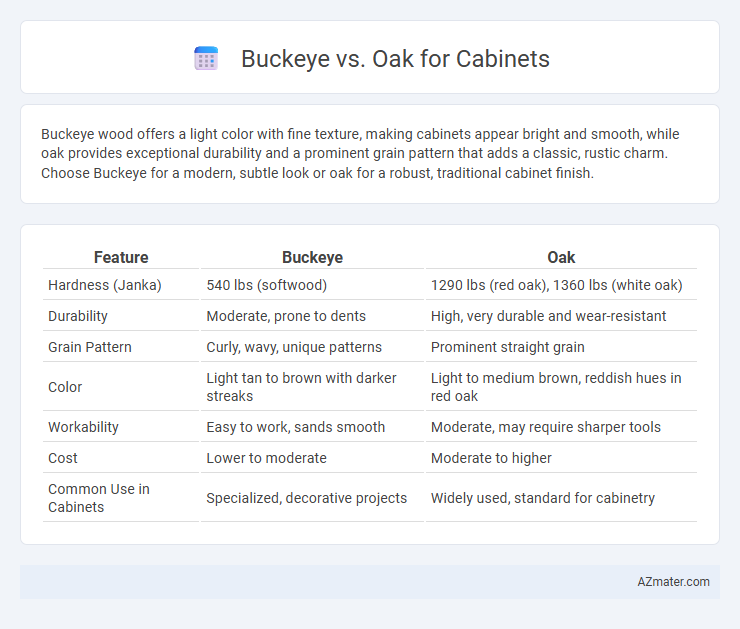Buckeye wood offers a light color with fine texture, making cabinets appear bright and smooth, while oak provides exceptional durability and a prominent grain pattern that adds a classic, rustic charm. Choose Buckeye for a modern, subtle look or oak for a robust, traditional cabinet finish.
Table of Comparison
| Feature | Buckeye | Oak |
|---|---|---|
| Hardness (Janka) | 540 lbs (softwood) | 1290 lbs (red oak), 1360 lbs (white oak) |
| Durability | Moderate, prone to dents | High, very durable and wear-resistant |
| Grain Pattern | Curly, wavy, unique patterns | Prominent straight grain |
| Color | Light tan to brown with darker streaks | Light to medium brown, reddish hues in red oak |
| Workability | Easy to work, sands smooth | Moderate, may require sharper tools |
| Cost | Lower to moderate | Moderate to higher |
| Common Use in Cabinets | Specialized, decorative projects | Widely used, standard for cabinetry |
Buckeye vs Oak for Cabinets: A Comprehensive Comparison
Buckeye wood offers a lighter, more uniform grain and is less dense compared to oak, making it easier to work with for cabinet construction. Oak features a prominent grain pattern and higher durability, ideal for heavy-use cabinetry requiring long-term wear resistance. Choosing between Buckeye and Oak for cabinets depends on the desired aesthetic, hardness, and maintenance needs, with Buckeye providing a softer, more subtle look and Oak delivering strength and classic appeal.
Key Differences in Appearance: Buckeye and Oak Cabinets
Buckeye cabinets exhibit a distinctive pale cream to light brown color with occasional reddish streaks, featuring a fine, straight grain pattern that offers a smooth and uniform surface. Oak cabinets, in contrast, are known for their prominent grain patterns with cathedrals and a coarse texture, ranging from light tan to deep reddish-brown hues depending on the species (red or white oak). The subtle, understated look of Buckeye provides a modern aesthetic, while Oak's pronounced grain and varied color tones contribute to a classic, rustic appearance in cabinetry.
Durability and Strength: Buckeye vs Oak Wood
Oak wood is renowned for its exceptional strength and durability, making it a top choice for cabinetry that withstands heavy use and resists dents and scratches. Buckeye wood, while moderately durable, is softer and less dense than oak, resulting in lower resistance to wear and impact. For long-lasting, sturdy cabinets, oak's superior hardness and structural integrity provide a significant advantage over buckeye.
Grain Patterns and Texture: Choosing Between Buckeye and Oak
Buckeye wood exhibits a light, creamy color with distinctive swirling grain patterns and a fine, smooth texture, making it ideal for cabinets that demand a unique and artistic appearance. Oak, available in red and white varieties, features prominent, straight-to-curved grain lines with a coarse, open texture known for durability and traditional aesthetics in cabinetry. Selecting between Buckeye and Oak hinges on the desired visual impact: Buckeye offers striking, unpredictable grain patterns, while Oak provides classic, consistent grains with a robust texture.
Cost Considerations: Buckeye vs Oak Cabinets
Buckeye cabinets generally cost less than oak due to the wood's faster growth rate and wider availability, making it a budget-friendly option for homeowners. Oak cabinets command a higher price because of their durability, distinctive grain, and long-lasting quality, often considered an investment for quality kitchens. When budgeting for cabinetry, choosing Buckeye offers cost savings upfront, while oak promises long-term value through its resilience and classic appeal.
Workability: Buckeye vs Oak for Cabinet Construction
Buckeye wood offers excellent workability due to its fine, even texture and softness, making it easier to cut, shape, and carve compared to oak. In contrast, oak is significantly harder and denser, requiring more effort and specialized tools during cabinet construction but providing superior durability. Cabinetmakers often prefer buckeye when intricate detailing and smoother finishes are needed, while oak is favored for its strength and resistance to wear in heavy-use environments.
Maintenance and Cleaning: Buckeye vs Oak Cabinets
Buckeye cabinets require minimal maintenance due to their natural resistance to moisture and decay, making cleaning straightforward with mild soap and water. Oak cabinets demand more frequent upkeep as their porous grain can absorb spills, necessitating regular sealing and careful cleaning to prevent stains and damage. Both woods benefit from avoiding harsh chemicals, but Buckeye's durability typically results in lower long-term maintenance costs compared to oak.
Environmental Impact: Sustainability of Buckeye and Oak
Buckeye and oak differ significantly in environmental impact, with oak being a hardwood known for its durability and slower growth rate, which raises concerns about sustainable harvesting and deforestation. Buckeye, a softer wood, grows more rapidly and can be sourced from managed forests or reclaimed wood, offering a more sustainable option with lower ecological footprint. Choosing buckeye cabinets promotes sustainability by reducing demand for slow-growing hardwoods like oak, thereby supporting forest conservation and biodiversity.
Best Uses: Where Buckeye or Oak Cabinets Excel
Buckeye cabinets excel in rustic and traditional settings due to their unique grain patterns and warm, rich color variations, making them ideal for cozy kitchens and natural-themed interiors. Oak cabinets are highly durable with a tight, prominent grain, perfect for high-traffic areas and classic or transitional designs requiring longevity and timeless appeal. Both woods perform well in kitchens and bathrooms, but Buckeye's distinctive look suits statement cabinetry, while Oak's strength and versatility make it the preferred choice for extensive cabinetry installations.
Final Verdict: Which Wood Is Right for Your Cabinets?
Buckeye wood offers a smooth grain and light color that suits modern, minimalist cabinets, while oak provides superior strength, durability, and a pronounced grain ideal for traditional or rustic styles. Oak's dense hardness ensures long-lasting cabinets resistant to dents and wear, making it a practical choice in high-traffic kitchens. For homeowners prioritizing durability and classic aesthetics, oak is the optimal cabinet wood, whereas Buckeye works best for those seeking a unique, lighter, and more contemporary finish.

Infographic: Buckeye vs Oak for Cabinet
 azmater.com
azmater.com